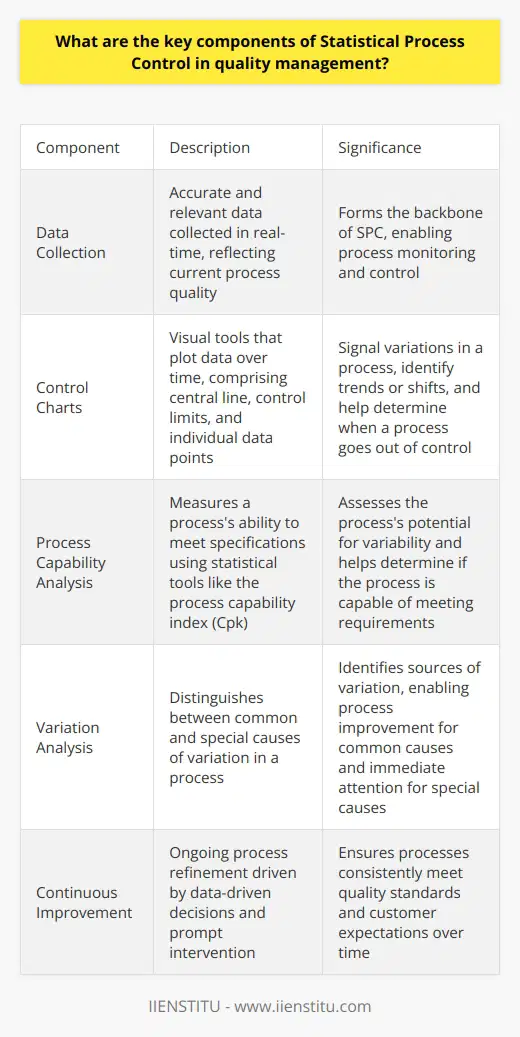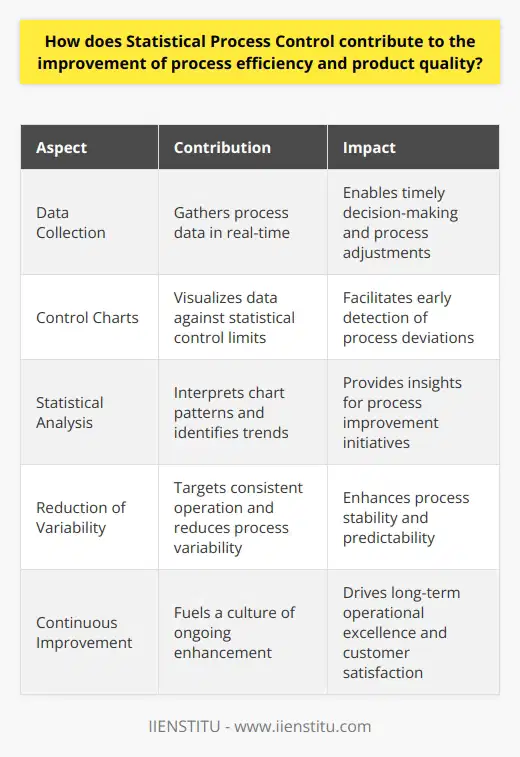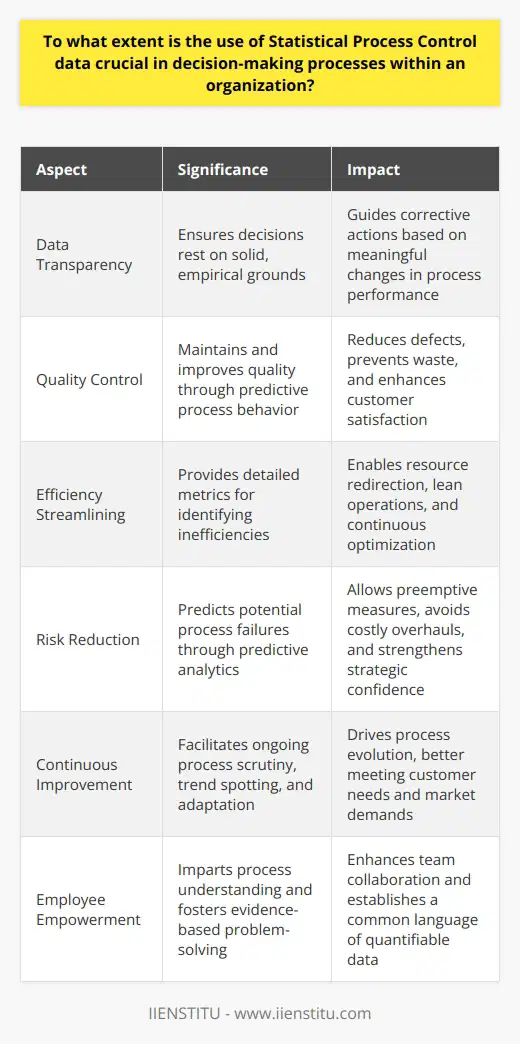
In an age where quality is not just an expectation but a benchmark for consumer trust and business efficiency, applying statistical methodologies to understand and improve process controls stands critical. Statistical Process Control (SPC) is a scientific method that utilizes statistical techniques to monitor and control a process, ensuring that it operates at its fullest potential. By measuring and analyzing variation within processes, SPC helps identify and eliminate causes of inefficiency, leading to an enhanced quality of products and services. This blog offers a deep-dive into the pools of SPC, exploring its historical context, principles, roles, benefits, application across industries, challenges during implementation, and the undeniably significant influence it has on quality management.
Comprehensive Guide To Regression Analysis For Quantitative Forecasting
Historical Overview of Statistical Process Control
Origin and evolution of SPC: Statistical Process Control traces its roots back to the early 1920s when Walter A. Shewhart introduced the concept while working at Bell Laboratories. Shewhart recognized that by measuring and controlling variation, one could assure quality control within mass manufacturing processes. This marked the inception of the Control Chart, a pivotal tool in SPC, which distinguished between common, natural process variations and variations that signified a process deviation.
Notable figures and their contributions to SPC: Shewhart's work laid the foundation of SPC but it didn't stop there. During World War II, W. Edwards Deming and Joseph Juran promulgated the use of SPC in the manufacturing industry to improve production quality for military equipment. Post-war, these methodologies were further carried to Japan, substantially aiding their economic growth and quality revolution. The teachings and philosophies of these quality pioneers continue to resonate within today's SPC strategies.
Different statistical methodologies used over time: The evolution of SPC over the years has seen an expansive use of various statistical methodologies. From basic quality tools like Histograms and Pareto Charts to complex analysis methods like Design of Experiments (DOE), these techniques collectively empower a detailed inspection of process performance. This ensures that every significant aspect that influences the quality and efficiency of processes can be quantitatively measured and improved upon.
Principles of Statistical Process Control
Explanation of Control Charts: The cornerstone of SPC is the Control Chart, a graphical representation that displays process data over time and contrasts it with calculated control limits. Understanding normal patterns within these charts means recognizing the process variability due to common, inherent causes. However, points that fall outside the established control limits often indicate a special cause that demands investigation, denoting that a process is out-of-control.
Illustrative examples of Control Charts: To elucidate, consider the manufacturing process of automotive parts where dimensions must be within specified tolerances. A Control Chart of part diameters over time could reveal a stable process or indicate a shift due to tool wear. By observing this chart, quality engineers can react before the part sizes fall out of the tolerance range, preventing potential recalls or reworks.
Explanation of Process Capability: Process Capability is another essential aspect of SPC. Indicators like Cp and Cpk quantify how well a process can produce output within specified limits. A Cp value depicts the process's potential capability, while Cpk gives an adjusted measure accounting for the process's mean relative to target specifications. Understanding these metrics allows businesses to gauge their process's ability to meet quality standards consistently.
Introduction to Cp and Cpk
Take, for example, the pharmaceutical industry where capsule filling needs to be precise. A high Cp value suggests the process has the potential to meet tolerance; however, if the filling process is not centered, the Cpk value will be lower indicating a need for adjustment. Both values provide a nuanced understanding of the process capability.
Real-world example showcasing Process Capability: In the injection molding industry, ensuring the visual and functional quality of components is imperative. Process Capability analysis reveals the degree to which a process can reliably produce parts that adhere to stringent aesthetic and functional standards. Through Cp and Cpk, managers can decide if the process is robust enough or needs refinement.
Special and Common Cause Variations: Every process has inherent variations; this is where distinguishing between Special and Common Cause Variations becomes critical. Common cause variations are systemic, a natural part of the process that usually requires a change in the system for improvement. Special cause variations, however, result from identifiable, often external factors that can be corrected individually.
Differentiating between the two types of variations: Understanding this difference allows practitioners to apply the correct method of correction. For instance, if machine calibration drifts over time leading to deviating product sizes, it is a common cause variation and indicates the need for a system change such as regular recalibrations. Conversely, a sudden change in raw material quality causing defects would be a special cause variation, often fixable by altering the specific batch or supplier.
Practical examples of both types: Consider a call center experiencing variation in customer call handle times. If the variation is consistent with a stable pattern, this indicates a common cause that may be due to the nature of the inquiries or systematic inefficiency. If a sudden spike in call times occurs, perhaps due to a product issue leading to complex queries, this would be categorized as a special cause that needs direct attention.
Roles and Benefits of Statistical Process Control in Quality Management
Comprehensive Guide To Decision Matrices For İmproved Decision-making Processes
Comprehensive Guide For Fishbone Diagrams İn Decision Making
Role of SPC in Quality Control: In quality control, SPC is invaluable as it allows for the real-time detection of process irregularities. Through its steady monitoring and data analysis capabilities, deviations are spotted swiftly, leading to prompt corrective actions. This proactive approach precludes the rise of significant quality issues, ensuring high quality output is maintained.
Application of SPC in detecting irregularities: Manufacturing environments benefit massively from such applications, where continuous monitoring of assembly line production via SPC can raise alerts for quick intervention. This real-time oversight dramatically reduces the chances for poor quality or unsafe products reaching the consumer.
Benefits of early detection of process errors with SPC: The advantage of early detection is not merely preserving product integrity but also cost-effectiveness. Early intervention often mitigates the need for large-scale product recalls or extensive reworks, translating into tangible savings and maintaining a reputable brand image.
Role of SPC in Continuous Improvement: Continuous improvement is a central tenet of quality management philosophy, and SPC plays a significant role in this realm. By analyzing the data trends over time, SPC pinpoints areas where processes can be more efficient providing a roadmap for incremental and ongoing improvements.
Influence of SPC in identifying opportunities for process improvements: Introducing SPC in environments such as a service industry scenario, for instance, can highlight the less apparent inefficiencies which, when addressed, significantly improve customer satisfaction and thus, overall business performance.
Case study highlighting the importance of SPC in process enhancements: Consider a global logistics company using SPC to analyze delivery times; by identifying patterns and setting control limits, the company can streamline operations and reduce both delivery times and expenditure related to fuel costs and staffing.
Role of SPC in Cost Reduction and Profitability: The role of SPC in driving down costs while simultaneously growing profitability is considerable. Through its tight process controls, companies can reduce waste, rework, and scrap, leading directly to a more lean and profitable operation.
Description of how process efficiency achieved through SPC can lead to cost reduction: For instance, in a heavy machinery production line, tightening process controls can result in a significant reduction of material waste and time delays, which directly impacts the bottom line in favorable terms.
An illustrative example showing the correlation between SPC and profitability: To illustrate, a tech company implementing SPC to fine-tune their software development process could see a decrease in debugging time and post-launch patches. Resultantly, this not only cuts the labor and operational costs but also accelerates the time-to-market, enhancing profit margins.
Applications and Relevance of SPC in Different Industries
Applications of SPC in Manufacturing Industry: The manufacturing industry, with its focus on consistent production quality and efficiency, heavily relies on SPC. From automotive to electronics, utilizing SPC helps ensure products meet stringent quality guidelines, reducing variation and enhancing customer satisfaction.
Applications of SPC in Healthcare Industry: In healthcare, SPC's application centers on patient safety and care quality. From monitoring surgical procedure times to controlling medication dosages, SPC fosters an environment characterized by continuous quality improvement.
Applications of SPC in Food and Beverage Industry: SPC in the food and beverage industry is equally critical, where maintaining product quality and safety is a regulatory and ethical imperative. Employing SPC ensures adherence to quality standards and can monitor critical parameters like temperature and pH levels.
Comparing and contrasting the use of SPC across these domains: Although SPC’s fundamentals remain the same, the metrics and control limits differ per industry based on their unique variables and requirements. Comparatively, the rigid quality demands in healthcare demonstrate a more stringent use of SPC as opposed to the broader application in manufacturing. This versatility accentuates its universal applicability.
Challenges Encountered in Implementing Statistical Process Control
Understanding the most common obstacles in SPC adoption: Adoption of SPC is not without challenges, from resistance to change within an organization to a lack of statistical expertise, obstacles abound. Ensuring successful implementation necessitates addressing these hurdles head-on.
Tips for overcoming these challenges: To overcome resistance, companies are encouraged to engage in problem solving skills training and promote the resultant benefits to all stakeholders meticulously. Furthermore, providing online certificate courses in SPC can equip employees with the required knowledge, ushering smoother transitions.
Importance and benefits of training and education in successful SPC implementation: Investing in training and education reinforces the importance of quality culture while simultaneously demonstrating the organization's commitment to empowering its workforce. This propels the success rates of SPC implementation by integrating statistical thinking into the fabric of daily operations.
Conclusion
Summarizing the importance and benefits of SPC
Throughout the detailed inspection of Statistical Process Control as the fulcrum of quality management, it's abundantly clear that the structured and scientific utilization of SPC tools is indispensable for any organization intent on delivering consistently high-quality products or services.
Encouraging the reader to further explore and implement the concepts of SPC in their business practices.
Businesses are thus encouraged to peek beyond the veil of SPC's initial complexity to discern the immense potential it holds for process improvement and economic efficiency. It is an investment with returns manifested in superior product quality, customer satisfaction, and heightened profitability.
Final thoughts and future perspectives in the field of Statistical Process Control.
As the landscape of industries continues to evolve, so will the methodologies and technology supporting SPC. It is a dynamic, robust practice capable of undergirding the future of quality management. Embracing SPC concepts will not only fortify existing processes but will also serve as a compass guiding businesses towards an optimally managed future.
Frequently Asked Questions
What are the key components of Statistical Process Control in quality management?
Statistical Process Control (SPC) plays a crucial role in quality management. It relies on statistics and control charts to monitor and control a process. SPC ensures that the process operates at its full potential. Here, we discuss the key components of SPC in quality management.
Data Collection
Data forms the backbone of SPC. You need accurate and relevant data to perform SPC. Data collection occurs in real-time. It must reflect the current process quality.
Control Charts
Control charts are pivotal in SPC. They signal variations in a process. These charts plot data over time. They help identify trends or shifts in a process. Control charts comprise several key elements:
Central Line
The central line represents the process average. It serves as a reference point. It allows for comparison between actual performance and process average.
Control Limits
Control limits define process variability. They are not specifications or targets. Upper and Lower Control Limits (UCL and LCL) bracket the central line. They signal when a process goes out of control.
Points
Individual data points represent sampled measurements. These points plot on the chart over time. They show variations from the process average.
Process Capability Analysis
Capability analysis measures a process's ability to meet specifications. It uses statistical tools to assess performance. The process capability index (Cpk) is one such tool. It evaluates the process's potential for variability.
Variation Analysis
Variation is inherent in every process. SPC distinguishes between common and special causes of variation. Common causes are natural to the process. They require process improvement to eliminate. Special causes arise from external factors. They call for immediate attention.
Continuous Improvement
SPC drives ongoing process improvements. It allows teams to make data-driven decisions. Continuous monitoring spots problems early. It facilitates prompt intervention. Over time, SPC helps to refine processes and improve quality.
Employee Involvement
Successful SPC requires employee engagement. Workers must understand SPC principles. They contribute to data collection and analysis. Their involvement ensures accurate and timely process control.
Training and Education
Effective SPC requires proper training. Employees must understand statistical methods. They need skills to interpret control charts correctly. Education enables employees to engage with SPC fully.
Software and Tools
SPC software simplifies data analysis and charting. It provides automated tools for control charts and reports. The right software helps manage and interpret large data sets.
In essence, SPC incorporates tools, techniques, and practices. It focuses on monitoring and controlling processes. This aims to achieve and maintain an optimized level of quality. SPC stands as a pillar of quality management. It ensures that products meet customer expectations consistently.

How does Statistical Process Control contribute to the improvement of process efficiency and product quality?
Understanding Statistical Process Control (SPC)
Statistical Process Control (SPC) stands at the forefront of quality assurance. It offers a structured approach to monitor and control process performance. Its foundation lies in statistical methods. These provide objective criteria for decision-making.
Critical Components of SPC
SPC hinges on several key elements. These elements ensure a methodical approach to quality management.
- Data Collection: It begins with gathering process data in real-time.
- Control Charts: These charts visualize data against statistical control limits.
- Statistical Analysis: Experts use this to interpret chart patterns.
Enhancing Process Efficiency
How does SPC enhance efficiency? It does so by promoting a proactive culture.
- Early Detection: It enables early identification of process deviations.
- Reduction of Variability: SPC targets consistent operation. It reduces process variability.
- Waste Minimization: Efficient processes generate less waste. SPC aids in achieving such efficiency.
When processes operate more predictably, they are naturally more efficient. SPC pinpoints issues before they escalate. Thus, corrections occur promptly, saving time and resources.
Improving Product Quality
High product quality stems from stable processes. SPC plays a critical role here.
- Quality Assurance: It provides a systematic approach to quality control.
- Continuous Improvement: SPC fuels a culture of ongoing enhancement.
- Customer Satisfaction: High quality boosts customer trust and satisfaction.
By monitoring and maintaining process stability, SPC assures consistent quality. It helps to minimize defects and improve overall product standards.
Conclusion
SPC contributes significantly to both process efficiency and product quality. Its reliance on statistical tools helps pinpoint areas needing improvement. Those improvements lead to reduced process variability and better quality outcomes. With SPC, businesses can achieve operational excellence and enhance customer satisfaction.

To what extent is the use of Statistical Process Control data crucial in decision-making processes within an organization?
The Crux of Statistical Process Control in Organizational Decisions
Statistical Process Control (SPC) stands as a methodological stalwart. It gives organizations a powerful lens. Managers can monitor and control production processes. SPC relies on statistical methods. These methods chart process performance over time. They help in identifying variability. Variability can stem from common or special causes.
Data Transparency Affords Informed Decision-Making
Data-driven approaches shape modern management. Foremost among these is SPC. It ensures decisions rest on solid, empirical grounds. Clarity in data interpretation becomes paramount. Leaders can see true process performance. They discern between random fluctuations and meaningful change. This distinction guides corrective actions.
The Role of SPC in Quality Control
Quality remains a non-negotiable organizational pillar. SPC maintains and improves quality. How? By predicting process behavior. It enables proactive quality management. Businesses can reduce defects. They prevent waste. They improve customer satisfaction. SPC data serve as a critical feedback mechanism.
Streamlining Efficiency With Precise Metrics
Efficiency demands the elimination of unnecessary processes. SPC assists with detailed metrics. Managers gain insights into inefficiencies. They can redirect resources with precision. Operations adopt lean principles. They maximize output while minimizing waste. This process is continuous. It leans heavily on SPC charts and data analysis.
Risk Reduction Through Predictive Analytics
Every decision carries risk. SPC minimizes this risk. It predicts potential process failures. Organizations can take preemptive steps. They avoid costly overhauls. They fend off customer dissatisfaction. Reliability in process outcomes increases. Confidence in organizational strategies strengthens.
Continuous Improvement Driven by SPC
Improvement requires constant evaluation. SPC provides ongoing process scrutiny. It spots trends and patterns. It helps organizations adapt. Processes evolve. They better meet customer needs and market demands. Continuous improvement cycles become inherent. They are data-centered. They are SPC-backed.
Employee Empowerment Through Data
Employees influence process outcomes. SPC imparts understanding. Workers engage with processes more meaningfully. They solve problems with evidence. Teams collaborate better. They share a common language. It is the language of data. It is clear. It is quantifiable.
SPC as a Strategic Asset
SPC is not just a tool. It is a strategic asset. It aligns with organizational goals. Decisions align with measurable outcomes. SPC provides the roadmap. It guides process optimization. It secures competitive advantage in the market.
In conclusion, SPC data are vital. They underlie informed and strategic decisions. They permeate every level of an organization. They drive quality, efficiency, and continuous improvement. SPC is the cornerstone of a data-centric culture. It fosters accountability. It enhances operational excellence. Without it, organizations risk uninformed choices. They risk stagnation. With it, they thrive on insight and innovation.



